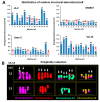Karyotypic Flexibility of the Complex Cancer Genome and the Role of Polyploidization in Maintenance of Structural Integrity of Cancer Chromosomes
- PMID: 32150835
- PMCID: PMC7139464
- DOI: 10.3390/cancers12030591
Karyotypic Flexibility of the Complex Cancer Genome and the Role of Polyploidization in Maintenance of Structural Integrity of Cancer Chromosomes
Abstract
Ongoing chromosomal instability in neoplasia (CIN) generates intratumor genomic heterogeneity and limits the efficiency of oncotherapeutics. Neoplastic human cells utilizing the alternative lengthening of telomeres (ALT)-pathway, display extensive structural and numerical CIN. To unravel patterns of genome evolution driven by oncogene-replication stress, telomere dysfunction, or genotoxic therapeutic interventions, we examined by comparative genomic hybridization five karyotypically-diverse outcomes of the ALT osteosarcoma cell line U2-OS. These results demonstrate a high tendency of the complex cancer genome to perpetuate specific genomic imbalances despite the karyotypic evolution, indicating an ongoing process of genome dosage maintenance. Molecular karyotyping in four ALT human cell lines showed that mitotic cells with low levels of random structural CIN display frequent evidence of whole genome doubling (WGD), suggesting that WGD may protect clonal chromosome aberrations from hypermutation. We tested this longstanding hypothesis in ALT cells exposed to gamma irradiation or to inducible DNA replication stress under overexpression of p21. Single-cell cytogenomic analyses revealed that although polyploidization promotes genomic heterogeneity, it also protects the complex cancer genome and hence confers genotoxic therapy resistance by generating identical extra copies of driver chromosomal aberrations, which can be spared in the process of tumor evolution if they undergo unstable or unfit rearrangements.
Keywords: DNA replication stress; alternative lengthening of telomeres (ALT); chromosomal instability in neoplasia (CIN); intratumor genomic heterogeneity; polyploidy; therapy resistance; whole genome doubling (WGD).
Conflict of interest statement
The authors declare no conflict of interest.
Figures



Similar articles
-
Alternative lengthening of telomeres: recurrent cytogenetic aberrations and chromosome stability under extreme telomere dysfunction.Neoplasia. 2013 Nov;15(11):1301-13. doi: 10.1593/neo.131574. Neoplasia. 2013. PMID: 24339742 Free PMC article.
-
Correlating breakage-fusion-bridge events with the overall chromosomal instability and in vitro karyotype evolution in prostate cancer.Cytogenet Genome Res. 2007;116(1-2):1-11. doi: 10.1159/000097411. Cytogenet Genome Res. 2007. PMID: 17268171
-
Stochastic cancer progression driven by non-clonal chromosome aberrations.J Cell Physiol. 2006 Aug;208(2):461-72. doi: 10.1002/jcp.20685. J Cell Physiol. 2006. PMID: 16688757
-
Resolving Roadblocks to Telomere Replication.Methods Mol Biol. 2019;1999:31-57. doi: 10.1007/978-1-4939-9500-4_2. Methods Mol Biol. 2019. PMID: 31127568 Review.
-
Telomere-driven genomic instability in cancer cells.Cancer Lett. 2003 May 15;194(2):173-82. doi: 10.1016/s0304-3835(02)00704-8. Cancer Lett. 2003. PMID: 12757975 Review.
Cited by
-
Developing Bottom-Up Induced Pluripotent Stem Cell Derived Solid Tumor Models Using Precision Genome Editing Technologies.CRISPR J. 2022 Aug;5(4):517-535. doi: 10.1089/crispr.2022.0032. CRISPR J. 2022. PMID: 35972367 Free PMC article. Review.
-
AGO2 localizes to cytokinetic protrusions in a p38-dependent manner and is needed for accurate cell division.Commun Biol. 2021 Jun 11;4(1):726. doi: 10.1038/s42003-021-02130-0. Commun Biol. 2021. PMID: 34117353 Free PMC article.
-
Karyotype Aberrations in Action: The Evolution of Cancer Genomes and the Tumor Microenvironment.Genes (Basel). 2021 Apr 12;12(4):558. doi: 10.3390/genes12040558. Genes (Basel). 2021. PMID: 33921421 Free PMC article. Review.
-
Generation and characterization of human U-2 OS cell lines with the CRISPR/Cas9-edited protoporphyrinogen oxidase IX gene.Sci Rep. 2022 Oct 12;12(1):17081. doi: 10.1038/s41598-022-21147-x. Sci Rep. 2022. PMID: 36224252 Free PMC article.
-
High-resolution genome-wide mapping of chromosome-arm-scale truncations induced by CRISPR-Cas9 editing.Nat Genet. 2024 Jul;56(7):1482-1493. doi: 10.1038/s41588-024-01758-y. Epub 2024 May 29. Nat Genet. 2024. PMID: 38811841 Free PMC article.
References
LinkOut - more resources
Full Text Sources

